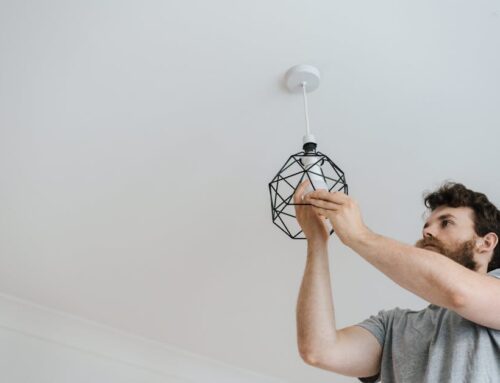The Growing Need for Home Security Systems
With the continuous advancement in technology and the increasing prevalence of property crimes, the need for home security systems has become more critical than ever. In recent years, trends indicate a rise in residential burglaries and unauthorized intrusions, emphasizing the need for effective preventative measures to safeguard homes and their occupants.
Several factors have contributed to the urgency for enhanced home security. According to data from the Federal Bureau of Investigation (FBI), there were an estimated 1,117,696 burglaries in the United States in 2019, resulting in $3 billion in property losses. The financial impact is only one aspect, as the psychological and emotional toll on victims can be profound.
Urbanization and the associated increase in housing density have also played a role in the growing need for security measures. As more people move into urban and suburban areas, the potential for criminal activity can rise, making the installation of home security systems a practical consideration for homeowners seeking to protect their assets and loved ones.
Furthermore, advancements in technology have made home security systems more accessible and efficient. Modern systems often include a combination of video surveillance, motion detectors, and alarm systems, which can provide real-time alerts and remote monitoring capabilities. This new era of smart home technology allows individuals to manage and monitor their security systems via smartphones and other internet-connected devices.
Insurance companies have also recognized the importance of home security systems. Many insurers offer discounts on premiums for homes equipped with security measures, further incentivizing homeowners to invest in these systems. This correlation between security systems and reduced insurance premiums is a testament to their effectiveness in mitigating risks associated with burglaries and other home invasions.
Overall, the growing need for home security systems is backed by substantial data and trends that highlight their role in enhancing residential safety. As crime rates evolve and technology continues to progress, the adoption of home security systems is likely to increase, providing homeowners with peace of mind and comprehensive protection.
Types of Home Security Systems Available
Home security systems come in various types, offering different levels of protection and functionality. Understanding these types can help homeowners select the best system for their needs.
Monitored Alarm Systems: These systems are monitored by a professional security company. When an alarm is triggered, the monitoring center is notified and can dispatch emergency services if necessary. Monitored alarms often include a monthly service fee but provide a high level of security and peace of mind.
Unmonitored Alarm Systems: Also known as self-monitored systems, these do not have professional monitoring. When an alarm is triggered, the system activates an audible and/or visual alarm to alert the homeowner and neighbors. Such systems rely on the homeowner to notify authorities if there’s a break-in.
Wired Security Systems: Wired systems use physical cables to connect sensors and the control panel. They are typically reliable and less prone to interference, though their installation can be complex and often requires professional assistance.
Wireless Security Systems: These systems use wireless technology to connect components, making them easier to install and more flexible. They are ideal for renters or those wanting a DIY solution, though they might be susceptible to signal interference and require regular battery changes.
Smart Home Security Systems: Integrating with smart home technology, these systems can be controlled via smartphones and other devices. Users can receive real-time alerts, view live camera feeds, and remotely control locks and lights. These systems provide added convenience and control but may be vulnerable to hacking if not properly secured.
Surveillance Cameras: Cameras can be standalone or part of a broader security system. They can deter crime, provide valuable evidence in the event of an incident, and allow for remote monitoring. Video doorbells and IP cameras are popular due to their ease of use and installation.
Environmental Sensors: Beyond intrusions, home security systems can include sensors for smoke, fire, carbon monoxide, and water leaks. These detectors provide comprehensive protection against various hazards, enhancing the safety of the home.
Access Control Systems: These manage who can enter specific areas of the home. They can include electronic locks, keypads, and biometric scanners. Access control systems offer advanced security by limiting entry to authorized individuals.
Door and Window Sensors: Basic yet crucial components of most security systems, these sensors alert homeowners when a door or window is opened. They are the first line of defense in detecting unauthorized entry.
In summary, the variety of home security systems available caters to different needs and preferences, from fully monitored and integrated smart systems to basic sensor setups. Homeowners should evaluate their specific requirements, budget, and desired level of control and monitoring when choosing a security system.
Statistical Benefits of Home Security Systems
Statistical data shows that homes equipped with security systems are significantly less likely to be targeted by burglars. Studies by the National Council for Home Safety and Security indicate that homes without a security system are 300% more likely to be burglarized.
Furthermore, the mere presence of a security system can act as a substantial deterrent. According to a report by the University of North Carolina at Charlotte’s Department of Criminal Justice and Criminology, around 60% of convicted burglars stated that the presence of a security system influenced their decision to target another home.
The benefits extend beyond just preventing break-ins. Home security systems can also play a crucial role in reducing emergency response times. Many modern systems are directly linked to emergency services, allowing for quicker alerts to fire departments, police, and medical responders. According to the Federal Emergency Management Agency (FEMA), this feature can help reduce property damage and increase the chances of saving lives during emergency situations.
Moreover, homes with security systems often experience fewer losses during burglaries. Data from the Insurance Information Institute (III) reveals that the average monetary loss in a home with an active security system is substantially lower compared to those without one. This directly translates into reduced financial strain and faster recovery for the homeowners.
Additional statistics from SafeWise, a leading resource for home security information, show that neighborhood security also benefits from individual installations. Nearly 83% of neighborhoods with higher concentrations of home security systems report lower crime rates, underscoring the community-wide impact of these systems.
Overall, the statistical benefits of installing a home security system are significant. These systems not only deter crime and protect property but also enhance community safety and ensure quicker emergency responses. The data clearly supports the effectiveness of home security systems in providing a safer living environment.
Technological Advances in Home Security
Recent technological advances have significantly increased the efficacy, accessibility, and sophistication of home security systems. Innovations in this field enhance the overall safety, usability, and reliability of these systems.
1. Smart Home Integration
One of the most significant technological advances is smart home integration. Home security systems can seamlessly interface with other smart home devices to create a cohesive and responsive home environment. Examples include smart locks, video doorbells, and voice-activated controls.
- Smart Locks: Allow homeowners to lock and unlock doors remotely, providing added convenience and security.
- Video Doorbells: Enable visual monitoring of visitors and package deliveries, regardless of the homeowner’s location.
- Voice-Activated Controls: Facilitate hands-free operation of security systems using voice commands through virtual assistants like Amazon Alexa and Google Assistant.
2. Advanced Surveillance Technology
Modern surveillance systems include high-definition cameras, night vision, and motion detection, providing clearer and more comprehensive monitoring.
- HD Cameras: Offer higher resolution images and video, making it easier to identify faces and details.
- Night Vision: Allows for surveillance in low-light conditions, enhancing security around the clock.
- Motion Detection: Triggers alerts when movement is detected, reducing false alarms and focusing attention on potential threats.
3. Mobile App Access and Remote Monitoring
Many home security systems now offer mobile applications that grant users real-time access and control over their systems. This feature promotes ease of use and constant connectivity.
- Real-Time Alerts: Notify homeowners of security breaches or other events immediately.
- Remote Arm/Disarm: Enable users to manage their security systems from anywhere in the world.
4. Artificial Intelligence and Machine Learning
Artificial Intelligence (AI) and Machine Learning (ML) are increasingly being incorporated to enhance the accuracy and effectiveness of security systems.
- Facial Recognition: Identifies known individuals and differentiates between residents and intruders.
- Behavioral Analysis: Learns routine patterns and spots anomalies that may indicate security threats.
5. Environmental Sensors
In addition to traditional security features, modern systems may include environmental sensors to detect smoke, carbon monoxide, and water leaks, offering comprehensive protection beyond intrusions.
- Smoke Detectors: Alert homeowners to potential fire hazards.
- Carbon Monoxide Detectors: Signal the presence of this dangerous gas, which is colorless and odorless.
- Water Leak Sensors: Warn of leaks that could lead to water damage or mold growth.
The following table summarizes some of the key technological advancements in home security systems:
| Technological Feature | Benefit |
|---|---|
| Smart Home Integration | Unified control, enhanced convenience, improved security |
| High-Definition Cameras | Clearer images, better identification |
| Artificial Intelligence | Improved accuracy, reduced false alarms |
| Environmental Sensors | Comprehensive home safety beyond intrusions |
Cost-Benefit Analysis of Home Security Systems
Conducting a cost-benefit analysis of installing a home security system involves examining both the financial implications and the qualitative advantages. Though the initial investment and potential recurring fees are considerations, the overall benefits typically outweigh the costs.
The initial costs associated with home security systems can vary significantly. According to recent market data, basic systems that include essential equipment such as door and window sensors, motion detectors, and a control panel can cost between $200 and $700 for purchase and installation. More advanced systems with additional features like surveillance cameras, smart home integration, and extended coverage can range from $1,000 to $3,000 or more.
Beyond the initial installation, there are recurring expenses to consider. Professional monitoring services, which provide 24/7 surveillance and alert emergency services when needed, generally cost between $10 and $60 per month, depending on the service provider and the level of monitoring. Additionally, some systems may have maintenance costs, particularly those with more complex technical components.
On the benefit side, home security systems offer significant savings and value. According to a study conducted by the University of North Carolina at Charlotte, security systems can reduce the likelihood of a home burglary by as much as 60%. Given that the FBI reports the average loss during a burglary is over $2,600, the potential avoidance of such incidents provides substantial financial justification for these systems.
Home security systems can also contribute to increased property values and make homes more attractive to potential buyers. Surveys indicate that homebuyers often cite security systems as a desirable feature, and homes equipped with these systems can command higher resale prices.
Moreover, some cities and towns offer tax incentives or rebates for homeowners who install security systems, further offsetting initial costs. Consumers are advised to check with local authorities to see if such programs are available in their area.
In conclusion, while the financial outlay for home security systems may seem substantial upfront, the reduction in burglary risks, potential cost savings on property loss, increase in home value, and additional benefits significantly outweigh the costs over time. Conducting a thorough cost-benefit analysis demonstrates the overall economic and qualitative advantages of investing in a home security system.
Impact on Insurance Premiums and Policies
Home security systems can play a crucial role in impacting insurance premiums and policies. Insurance companies recognize the value of these systems in reducing the risk of theft, vandalism, and other home-related incidents. As a result, the installation of a home security system can often lead to lower insurance premiums and more favorable policy terms for homeowners.
One significant way home security systems impact insurance premiums is through discounts offered by insurance providers. Many insurance companies provide discounts to policyholders who have installed home security systems. According to the Insurance Information Institute (III), these discounts can range from 5% to 20% depending on the complexity and capabilities of the system.
The factors that influence the discount rate include:
- Type of system: Basic systems that include alarms and surveillance cameras may offer lower discounts compared to more advanced systems that include professional monitoring and automated emergency responses.
- Monitoring services: Systems that connect to professional monitoring services tend to yield higher discounts because they ensure that any detected threats are promptly addressed, reducing the likelihood of significant damage or loss.
- Integration with other safety devices: Home security systems integrated with smoke detectors, fire alarms, and carbon monoxide detectors can further enhance discounts, as these integrations provide comprehensive protection.
Additionally, the installation of home security systems can affect the overall risk assessment by insurance providers. An effective security system reduces the likelihood of home invasions and burglaries, allowing insurance companies to perceive the property as lower risk. This lower risk often translates to more favorable insurance terms and conditions for the homeowner.
Furthermore, having a home security system may also be a requirement for certain insurance policies, particularly for high-value homes or properties located in areas with higher crime rates. By meeting these requirements, homeowners not only become eligible for coverage but may also benefit from additional policy provisions that further protect their assets.
In summary, the installation of a home security system has a positive impact on insurance premiums and policies. It lowers insurance costs through discounts, improves risk assessments, and can fulfill necessary requirements for obtaining certain policies. Homeowners should consult with their insurance providers to understand the specific benefits and savings associated with installing a home security system.
Psychological and Emotional Benefits
Home security systems provide not only physical protection but also significant psychological and emotional benefits for homeowners. Knowing that one’s home is safeguarded can lead to a substantial improvement in overall mental well-being.
One of the primary psychological benefits is peace of mind. The presence of a security system can help alleviate anxiety and stress related to potential break-ins or other home-related threats. This sense of safety is crucial, especially for individuals living in areas with higher crime rates or those who have been victims of burglary in the past.
Additionally, home security systems contribute to a feeling of control over one’s environment. By having the ability to monitor and manage their security system remotely, homeowners can feel more empowered and proactive in ensuring their own safety. This aspect is particularly important for families with children or elderly members, as it provides reassurance that their loved ones are protected.
Another significant emotional benefit is the reduction in fear. Security systems with alarms and surveillance features can deter potential intruders, reducing the likelihood of break-ins and the associated fear of crime. Visible security measures can provide an additional layer of comfort, making residents feel safer in their homes.
Furthermore, studies have shown that homes with security systems are less likely to be targeted by burglars. This deterrent effect can lead to improved perceptions of neighborhood safety, fostering a sense of community well-being. When residents feel secure, they are more likely to engage with their community, contribute to local initiatives, and build stronger social connections.
In summary, while the primary goal of home security systems is to provide physical protection, the psychological and emotional benefits are equally significant. By enhancing peace of mind, providing a sense of control, reducing fear, and contributing to community safety, these systems play a vital role in improving the overall quality of life for homeowners and their families.
Future Trends in Home Security Systems
As we look to the future, home security systems are set to become increasingly sophisticated and integrated with other smart home technologies. One trend that is gaining traction is the usage of artificial intelligence (AI) to enable more advanced threat detection and response. AI algorithms can analyze data from various sensors more efficiently and accurately, distinguishing between routine activities and potential security breaches.
Another promising development is the integration of Internet of Things (IoT) devices with home security systems. IoT devices allow for more comprehensive monitoring by linking different security components, like cameras, door locks, and motion sensors, into a cohesive network. This integrated approach enables real-time alerts and even remote control of security features through mobile apps.
The rise of cloud-based security systems is also noteworthy. These systems offer several advantages, such as increased storage capacity for video footage and enhanced data security. Cloud-based solutions often come with features like automatic updates and remote access, ensuring that the security system is always up-to-date with the latest technology.
Biometric authentication methods, including facial recognition and fingerprint scanning, are expected to become more prevalent. These methods provide higher security standards than traditional locks and passwords, making it significantly harder for unauthorized individuals to gain access.
Another trend is the incorporation of cybersecurity measures within home security systems. As these systems become more connected, the risk of cyber threats increases. Innovative solutions are being designed to protect both the physical and digital aspects of home security, ensuring comprehensive protection against a range of potential threats.
Lastly, more systems will likely rely on sustainable and renewable energy sources, such as solar power, to ensure they remain operational during power outages or emergencies. This trend not only enhances reliability but also contributes towards a more eco-friendly home environment.
In conclusion, the future of home security systems lies in greater integration with smart technology, enhanced detection capabilities, and improved user convenience. These advancements will provide homeowners with more effective, efficient, and reliable security solutions that address both physical and digital threats.













